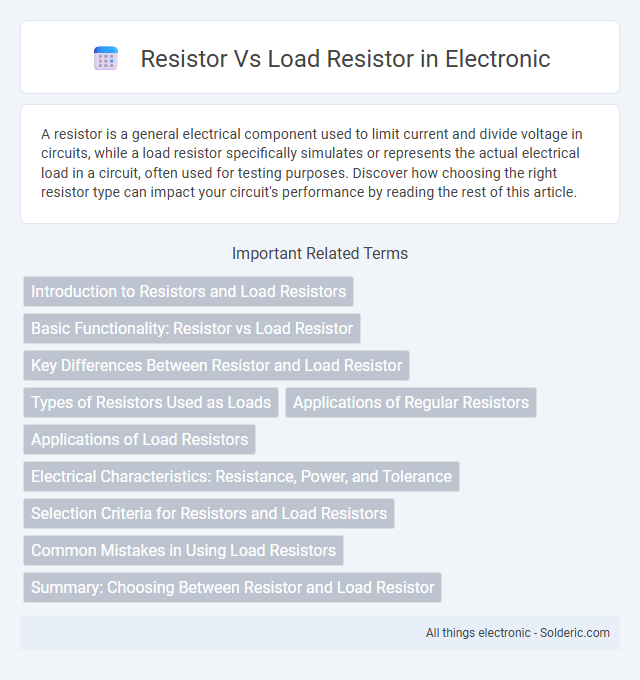A resistor is a general electrical component used to limit current and divide voltage in circuits, while a load resistor specifically simulates or represents the actual electrical load in a circuit, often used for testing purposes. Discover how choosing the right resistor type can impact your circuit's performance by reading the rest of this article.
Comparison Table
| Feature | Resistor | Load Resistor |
|---|---|---|
| Definition | Passive electrical component that limits current flow | Resistor used specifically to simulate or provide a load |
| Purpose | Control voltage and current in circuits | Emulate or apply specific load conditions for testing |
| Usage | General circuit applications like voltage dividers, biasing | Power supply testing, signal simulation, and load balancing |
| Power Rating | Varies widely (commonly 1/8W to several watts) | Usually higher, designed to handle sustained power dissipation |
| Placement | Anywhere in the circuit as required | Connected where load emulation or stabilization is needed |
| Example | 1kO resistor in a voltage divider | 10O, 10W resistor simulating a motor load |
Introduction to Resistors and Load Resistors
Resistors control electric current by providing a specific amount of resistance in a circuit, influencing voltage and current flow to achieve desired electrical behavior. Load resistors are specialized resistors designed to mimic the load an actual device would present, ensuring proper operation and stability in circuits such as power supplies and LED systems. Understanding your circuit's requirements helps determine whether a standard resistor or a load resistor is needed for optimal performance.
Basic Functionality: Resistor vs Load Resistor
A resistor limits electric current and controls voltage within circuits as a passive component, providing specific resistance values for various applications. A load resistor, specifically, simulates or provides a defined load on a circuit, ensuring stable operation or measuring current flow under expected conditions. Your circuit's performance depends on choosing the appropriate resistor type to match the intended functionality and electrical load requirements.
Key Differences Between Resistor and Load Resistor
A resistor is a passive electrical component designed to limit current and drop voltage within a circuit, while a load resistor specifically simulates or represents the electrical load in a circuit for testing or operating conditions. Unlike general resistors primarily intended for controlling current, load resistors must handle power dissipation and maintain stability under continuous load conditions, often rated for higher wattage. Key differences include their application purpose--load resistors mimic real device loads, whereas standard resistors serve broader current and voltage regulation roles in circuits.
Types of Resistors Used as Loads
Load resistors typically include fixed resistors such as carbon film, metal oxide, and wirewound types, each offering specific tolerance, power rating, and temperature stability suited for load applications. Variable resistors like potentiometers and rheostats are also used when adjustable load conditions are required. Your choice of resistor type depends on the load characteristics and the precision needed to simulate real-world operating conditions accurately.
Applications of Regular Resistors
Regular resistors are commonly used in electronic circuits to limit current flow, divide voltages, and protect components from damage. They serve critical roles in signal conditioning, biasing active elements such as transistors, and setting time constants in RC circuits. These resistors are fundamental in applications including LED drivers, audio equipment, and power supply regulation.
Applications of Load Resistors
Load resistors are primarily used in automotive lighting systems to simulate the electrical load of standard bulbs when LED replacements are installed, preventing hyper-flashing or error messages. They are essential in testing circuits to ensure accurate voltage and current readings under operational conditions. Your electronics projects benefit from load resistors by providing stable and predictable loads for power supply validation and device protection.
Electrical Characteristics: Resistance, Power, and Tolerance
Resistors exhibit specific electrical characteristics, including resistance value measured in ohms, power rating in watts, and tolerance expressed as a percentage, which defines the acceptable deviation from the nominal resistance. Load resistors, designed to simulate or replicate electrical loads, typically have precise resistance values and higher power ratings to safely dissipate heat under continuous or peak load conditions. Both standard and load resistors require appropriate tolerance levels to ensure circuit stability and performance accuracy, with load resistors often demanding tighter tolerances for reliable testing and operation.
Selection Criteria for Resistors and Load Resistors
Selection criteria for resistors emphasize resistance value accuracy, power rating, tolerance, and temperature coefficient to ensure optimal circuit performance. Load resistors require careful consideration of power dissipation, load regulation, and stability under varying electrical conditions. Both types must be chosen based on specific application requirements, including signal integrity and thermal management.
Common Mistakes in Using Load Resistors
Common mistakes in using load resistors include selecting an incorrect resistance value, which can lead to inaccurate voltage readings or circuit malfunctions. Failing to consider the power rating of the load resistor often results in overheating and potential component failure. Misplacing load resistors in sensitive signal lines can introduce noise or distortion, compromising overall circuit performance.
Summary: Choosing Between Resistor and Load Resistor
Choosing between a resistor and a load resistor depends on the application's specific requirements for current regulation and voltage stability. A load resistor is typically used to simulate a real load, ensuring consistent power dissipation and preventing circuit instability, while a standard resistor primarily limits current or divides voltage. Your choice impacts circuit performance, making it essential to match the resistor type to the intended electrical load conditions.
resistor vs load resistor Infographic

 solderic.com
solderic.com